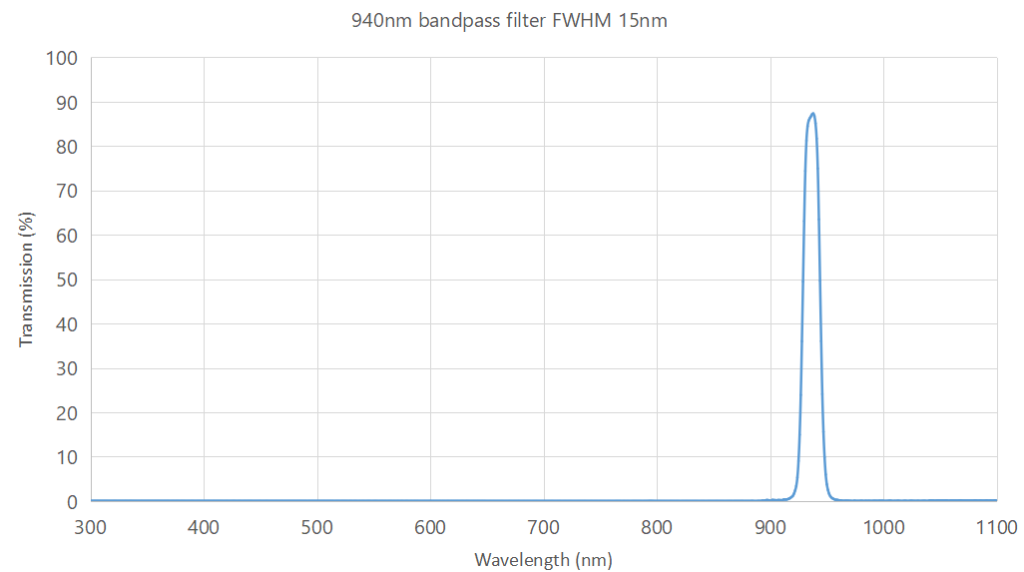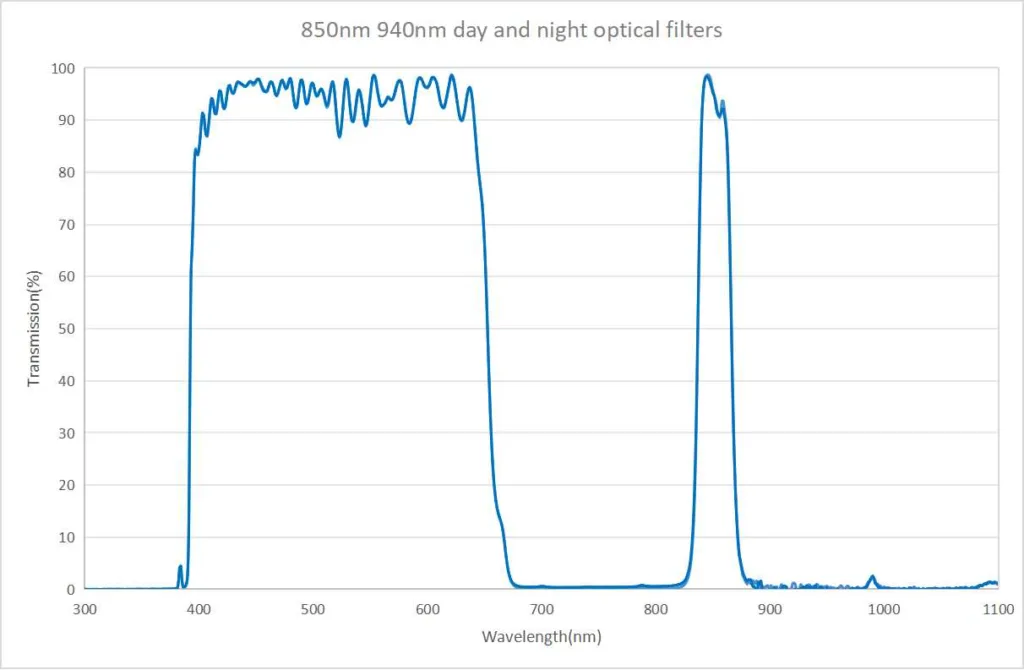Bandpass filters are used in optical systems to selectively allow light of a specific wavelength range to pass through while blocking light of other wavelengths.
This selective filtering characteristic makes bandpass filters widely used in spectral analysis, biomedical imaging, and other fields. In this article, we will introduce the principle, main types, design and manufacturing process, and specific application examples of band-pass filters.
The basic principle of band-pass filters

The working principle of bandpass filters is based on the interference phenomenon and the optical properties of multilayer films. By precisely designing the thickness of the film and the refractive index of the material, the filter can realize selective transmission of light at specific wavelengths.
Typically, a bandpass filter consists of multiple layers of dielectric films, with the thickness and refractive index of each layer precisely calculated to achieve the desired optical properties. These films are stacked together to selectively transmit certain wavelengths of light while reflecting or absorbing other wavelengths through interference effects.
Types of Bandpass Filters

Bandpass filters play an important role in the field of optics. Learn about the types of bandpass filters and explore their different characteristics and applications.
Narrowband Bandpass Filters
Narrowband bandpass filters are particularly important because of their extremely narrow transmission wavelength range (typically between a few nanometers and a few tens of nanometers), which requires extreme precision in their design to ensure high transmission rates.
The uniqueness of these filters lies in their ability to precisely select a specific wavelength, making them critical in applications that require tight wavelength control, such as laser spectroscopy, fluorescence microscopy, and astronomical observation.
For example, in fluorescence microscopy, narrowband filters can selectively allow only specific wavelengths of light to pass through, and this selectivity greatly improves the contrast and resolution of the imaging. Narrowband bandpass filters are therefore indispensable tools in scientific research and technology, especially in fine optical measurement and imaging techniques.

Wideband Bandpass Filter (Wideband Bandpass Filter)
Wideband bandpass filters are characterized by a wide range of transmission wavelengths, typically between tens and hundreds of nanometers.
Their advantages include high luminous flux and broad spectral coverage, and they are commonly used in optical systems with a wide wavelength range, such as beam splitting for multi-color light sources and white light imaging systems, to effectively separate different colors of light and improve optical performance.

Multiband Bandpass Filter (Multi Peak Bandpass Filter)
Multiband bandpass filters allow the passage of light at multiple discontinuous wavelength ranges. These filters can transmit light at multiple wavelengths simultaneously, making them suitable for multi-band detection and analysis.
Multi-peak bandpass filters are suitable for applications where multiple wavelength signals need to be detected at the same time, such as multi-color fluorescence imaging and multi-band spectral analysis. For example, in multi-band spectral analysis, multi-peak bandpass filters can be used to simultaneously detect spectral information at different wavelengths to improve analysis efficiency and accuracy.

Design and Fabrication of Band Pass Filters
The design and fabrication of bandpass filters is a complex and sophisticated process that requires consideration of several factors, such as material selection, film thickness, number of film layers, and fabrication process. The following are commonly used fabrication techniques:
Sputtering Coating (Sputtering)
Sputtering is a method of sputtering material atoms onto a substrate to form a thin film by bombarding the surface of the material with ions. This method allows precise control of the thickness and uniformity of the film.
Sputtering technology offers high precision, high uniformity, and good repeatability, making it suitable for the manufacture of high-quality optical filters.
Evaporation Coating (Evaporation)
Evaporation coating technology involves heating the material to the evaporation point, causing it to evaporate and condense on the substrate to form a thin film. This technique is easy to perform, cost-effective, and well-suited for mass production.
While evaporative coating technology may not be able to achieve extremely high film quality control, its cost-effectiveness and ease of operation make it ideal for applications where film quality is not particularly demanding.
Chemical Vapor Deposition (CVD)
Chemical vapor deposition (CVD) is a technique for depositing thin film materials on a substrate through a chemical reaction. This method enables the preparation of thin films with specific chemical and physical properties that are precisely controlled and are suitable for creating complex thin-film structures.
The strength of CVD technology lies in its versatility and flexibility, making it ideal for high-precision applications such as the manufacture of high-performance optical filters. Through precise process control, CVD can produce uniform and highly functional films that meet the stringent requirements of high-tech industries.
Application Examples of Band Pass Filters

Next, we will explore various real-world application cases of bandpass filters, showing how they play a key role in different technical contexts.
Spectral Analysis
Bandpass filters are used in spectral analysis to separate and detect spectral components at specific wavelengths. For example, in environmental monitoring, band-pass filters can be used to detect specific pollutants in the air, improving the sensitivity and accuracy of detection.
Astronomical Observation
In astronomy, bandpass filters are used to observe celestial radiation at specific wavelengths. For example, the Hα line of the hydrogen atom and the OIII line of the oxygen atom are common targets for astronomical observations. By using bandpass filters, these wavelengths of light can be effectively separated, improving the resolution and contrast of astronomical observations.
Biomedical imaging
Bandpass filters have important applications in fluorescence microscopy and optical tomography (OCT). For example, in fluorescence microscopy, bandpass filters can be used to selectively transmit specific wavelengths of light emitted by fluorescent dyes, thereby improving imaging contrast and resolution. In OCT, bandpass filters can improve the spectral resolution and imaging depth of the system.
Laser Systems
Bandpass filters are used in laser systems to select specific wavelengths of the laser beam. For example, in laser spectroscopy, narrow-band bandpass filters can be used to selectively transmit a specific wavelength of laser light, improving the accuracy and sensitivity of spectral analysis.
Conclusion
In summary, different types of bandpass filters have their own characteristics and application scenarios, and the performance and efficiency of optical systems can be significantly improved through rational selection and design of bandpass filters.
In the future, with the advancement of material science and manufacturing technology, bandpass filters will play a key role in more emerging fields. Whether in spectral analysis, astronomical observation or biomedical imaging, bandpass filters will continue to drive the progress of science and technology.
At the same time, Optolong website provides a variety of optical filters and customized services, please contact us for a quote!
